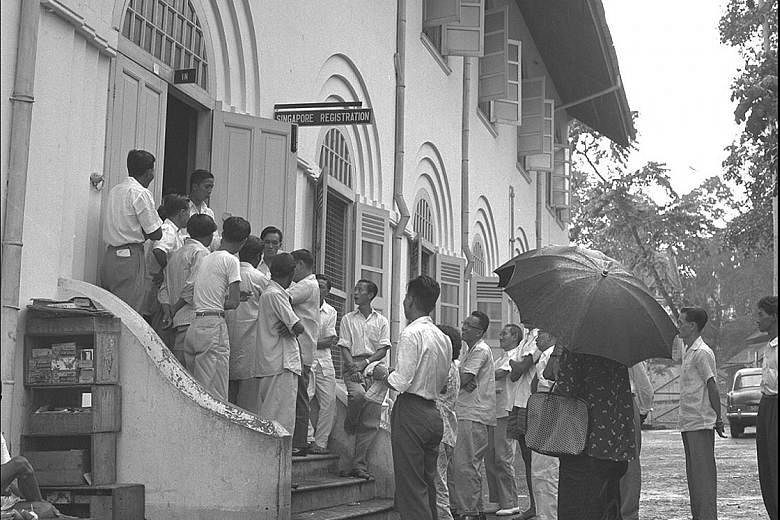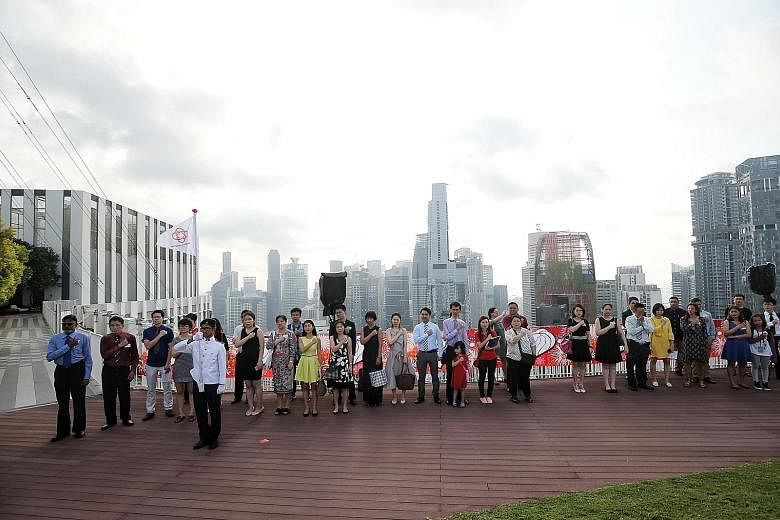"You go through one door, come out another door, and you are a Singapore citizen." So read an eye-catching quote by then Chief Minister Lim Yew Hock in a Straits Times report on Oct 15, 1957.
At a meeting with Chinese teachers, he sought to stress that an upcoming government campaign to register citizens - dubbed Operation Franchise - would be hassle-free.
The message was received.
Over a three-month window from November 1957 to January 1958, hundreds of thousands turned up to queue at registration points like the Singapore Citizenship Registry in Fort Canning Road, community centres and clan associations.
"Labourers, hawkers and millionaires queued up holding their application forms," said a news report.
In some cases, people waited more than an hour for their turn - but that did little to quell their eagerness, since some had waited decades for this moment.
The Chinese formed the bulk of those queueing, but there were also Indian and Malay registrants, and those of other races.
Millionaire banker Lien Ying Chow, among the first to submit papers, hailed the moment as important for overseas-born residents like himself who had worked hard to build a new life in Singapore.
India-born legislative assemblyman M.P.D. Nair registered, calling on others to follow, so that "they may help in shaping the destiny of our country".
By the end of Operation Franchise, more than 320,000 mostly foreign-born residents in Singapore had "come out another door" as Singapore citizens. A very big majority of those eligible signed up.
When added to a group of mainly local-born residents who were automatically considered citizens, the final tally was over 600,000 in total - the first people in history to be called Singapore citizens.
This year marks the 60th anniversary of the enactment of the Singapore Citizenship Ordinance of 1957, the law that gave birth, unexpectedly, to a new national identity.
What led to the passing of this ordinance? What was its significance? How did it shape the course of later events? And what future scenarios are possible for the Singapore citizenship?
Insight speaks to historians and experts to shed light on the subject.
TOWARDS SELF-GOVERNMENT
The Singapore Citizenship Ordinance of 1957 rested in a larger, post-World War II context. "The coloniser (Britain) no longer was untouchable and omnipotent," says Dr Sikko Visscher of the Royal Netherlands Academy of Arts and Sciences, who studied this period.
The Atlantic Charter between Britain and the United States put the self-government of colonies "firmly on the agenda". Britain was also under pressure from the British public "to give local society in their colonies a larger and more democratic say", he adds.
In Singapore, the elites of each ethnic community began to lobby the colonial government for change.
This was in part the result of the process of localisation - or "Malayanisation" - of the Chinese, Indian and other migrant communities in Singapore as they put down roots.
Professor Kwok Kian Woon of Nanyang Technological University adds: "From the late 1920s, you begin to see the educated Chinese debate in their writings about how the Chinese living in Malaya should relate to Malaya. And there was also the development of a distinct body of literature called mahua wenxue, or Malayan Chinese literature. An incipient Malayan identity was growing among the Chinese."
The fall of China to communist rule in 1949 accelerated the process, since the prospects of a return to China looked increasingly remote. Statements from China and India in the 1950s also encouraged domiciled Chinese and Indians in South-east Asia to take up citizenship.
By 1955, Singapore's newly elected Chief Minister David Marshall was calling for citizenship for Singapore's overseas-born residents, as part of a move towards greater autonomy.
The British had detached Singapore from Malaya constitutionally in 1946, with Malaya eventually achieving independence without Singapore in 1957. Singapore had to pursue its own path of constitutional change, with a vague eventual goal of independence through merger with Malaya.
Mr Marshall resigned when constitutional talks in Britain ended in failure. But Mr Lim Yew Hock, who took over, led a second delegation to London and secured a substantial commitment on autonomy - in part because "Lim was prepared to be tough with the communists", says Professor Tan Tai Yong of Yale-NUS College.
The deal was self-government, a fully-elected legislature and citizenship rights for an expanded electorate. "Self-government requires a representative legislative assembly. And for that assembly to be legitimate, you cannot have less than half the population voting," notes Prof Tan.
Within two days of Mr Lim's return in April 1957, he announced plans for citizenship. Six months later, the law was passed.
It created a new status - Singapore citizens.
Those born in Singapore automatically qualified. Those born in Malaya, Britain or other British colonies must have lived here for two years. Those born elsewhere, such as China, must have lived here for eight of the last 12 years - reduced from 10 of the last 12 years, after lobbying from Chinese groups.
Dual citizenship was only allowed for those born in Malaya and Britain. Those born in China or India had to renounce their citizenships. All registrants were also required to swear "to be faithful and bear true allegiance" to Britain's Queen and to the head of state in Singapore, and to "observe the laws of, and be a true, loyal and faithful citizen of Singapore".
CITIZENSHIP SINCE 1957
The ordinance took a very liberal, open-door stance on those born in China. All who arrived in Singapore before the war could become citizens in one fell swoop.
Criteria tightened considerably when Singapore joined Malaysia in 1963, and have been tight ever since.
Dr Seng Guo Quan of the National University of Singapore calls 1957 a "one-off political settlement". Dr Seng, whose grandfather became a citizen in 1957 (see other story), adds: "Singapore was looking forward to self-government and eventual independence through merger. It was simply not tenable to have a big group of immigrants in a state of limbo and thinking of another homeland."
Says Prof Tan Tai Yong: "There was a realisation that the Chinese and Indians would not be rooted without being given citizenship."
If the intention was to prod the overseas-born to make a commitment to Singapore, it does seem to have worked.
Says Associate Professor Eugene Tan of Singapore Management University: "There was in effect a new entity that required a sense of togetherness, a feeling of being one people, responsible for our own collective fate."
In 1959, a general election was held. The expanded electorate voted out Mr Lim Yew Hock, the man responsible for Operation Franchise - choosing instead as the new prime minister a young lawyer - Mr Lee Kuan Yew (see other story).
In 1963, Singapore merged with Malaya, Sabah and Sarawak to form Malaysia. All who were Singapore citizens under the 1957 ordinance stayed Singapore citizens, and took on Malaysian citizenship concurrently. Dual citizenship for British citizens ended.
In 1965, Singapore separated from Malaysia over irreconcilable differences on race issues. Conveniently and somewhat inadvertently, because the Singapore citizenship had existed since 1957, it did not seem absurd to many for Singapore to go it alone as an independent nation, despite the difficulties of nationhood for a small island.
In the early years after 1965, Singapore citizenship was mainly passed on by descent. There was naturalisation for some who moved here, but the numbers were small. There was also a tendency for foreigners in Singapore - including blue-collar workers - to eventually be granted permanent residency and citizenship if they sank roots.
But as the Singapore economy grew rapidly, the country attracted many more prospective immigrants, and the Government could be much more selective.
Today, most blue-collar workers are given work permits, with no path to citizenship. Skilled migrants can become citizens, but the criteria are fairly non-transparent.
Applicants know that factors like education, income, length of stay and family ties matter, but they are not sure how they add up - unlike in countries that use a point system such as Canada and Australia.
Associate Professor Elaine Ho of NUS says a move towards transparency is desirable. It reduces the emotional stress on applicants and helps them make informed choices.
In 2004, citizenship laws were changed to allow children born overseas to Singaporean mothers - and not just Singaporean fathers - to get citizenship.
The next significant milestone came around the 2011 General Election, amid unhappiness over the fast pace of immigration.
Although new citizen numbers had risen at a much slower pace than non-resident and permanent resident numbers, it was hard for Singaporeans to tell who was a new citizen and who was a permanent resident or employment pass holder.
Says Prof Eugene Tan: "Singaporeans questioned whether citizenship was being commoditised, and whether the ease with which to obtain (it) cheapened it."
The state responded in a few key ways, notes Institute of Policy Studies researcher Debbie Soon - moderating the number of immigrants, stating there should always be a strong core of citizens, and sharpening the difference in benefits between citizens and permanent residents in areas such as housing, education and healthcare.
As men who are naturalised as adults do not have to perform national service, "the state also moved to affirm the value of national service with measures such as vouchers to servicemen", she notes.
What are some future scenarios for Singapore citizenship? And how might the 1957 ordinance inform the way Singaporeans think about these futures?
One possibility is exploring dual citizenship (see other story).
On the issue of accepting new immigrants, Prof Eugene Tan says that with low birth rates and an ageing population here, immigration will continue to be important, although the Government will have to calibrate the numbers carefully and ensure infrastructure construction does not fall behind.
Prof Ho notes that the narrative so far has placed the burden on immigrants to integrate with Singapore.
"Integration is a two-way street. Singaporeans equally have to adapt to the changing demographics. This is where we might want to look back at 1957. The idea of a Singaporean identity then came about through an amalgamation of different cultures," she says.
And for Prof Kwok, 1957 also has implications for how Singaporeans think about multiracialism, both today and for decades to come.
Because the vast majority of the overseas-born given citizenship in 1957 were Chinese, it created a much bigger Chinese majority than would otherwise have been the case. This must always serve as a reminder to the Chinese majority that "they have an additional burden - indeed, a responsibility - to be aware and respectful of minorities and uphold multiracialism", he says.



